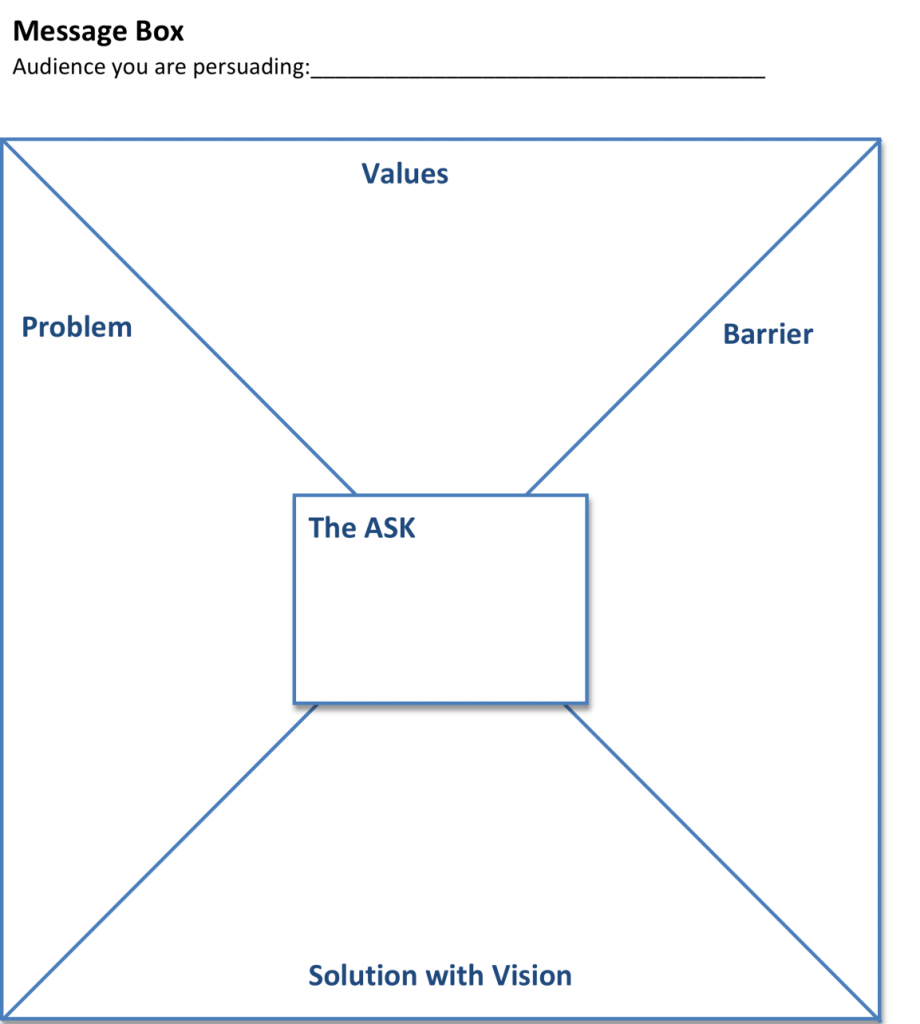Not sure what to say?
Almost every one of us learned how to be a good self-advocate from a very early age! The advocacy message is simply the act of promoting an issue, cause, or point of view. Your photovoice project became a public advocacy effort once you held your first photo exhibit. Hopefully, the experience helped you feel the power of advocating for yourself, for others, and for your community.
Advocacy Message
No matter what avenue you use to get your advocacy message out (e.g., speeches, letters to the editor, public rally) it is important to have a clear and persuasive message. The Advocacy Message Box is a great tool to help your team narrow your message to a few strong points that people will remember. Used well, it will help you create a message that connects with what people care about and will help your team focus on a clear message. The sample Message Box shown here will help when your team writes your message boxes.
Values
This is where your advocacy message should start. Why does this issue matter? Use values to connect to your audience (those you are trying to influence). Focus on THEIR values so you can connect with them and more easily motivate them to action. As a group, you can brainstorm the values your audience cares about and select those that seem to be most important to your audience. The values statement is the best place to ‘hook’ your audience and bring them along with you in your appeal for action.
Problems
Try to define the problem in a way that makes it important for everyone. The problem should be focused around the conditions surrounding people or an issue so your audience sees the general nature of the problem. Be careful when using individual examples so that those you are persuading don’t propose solutions for just those individuals! Individual examples are exactly that – examples that typically represent many others in a community. Your statement of the problem should seek policy and systems solutions and allow everyone to recognize just how interconnected we all are.
Barriers
Identify a barrier your audience might have that prevents them from taking action and pre-empt it by providing a reason the barrier can be dealt with. By proactively addressing their barrier, you reduce their ability to use the barrier/excuse as a reason for inaction. The key strategy here is not to repeat their misconception or barrier but to give the audience new information that can provide the solution to the barrier.
 Solution with Vision
Solution with Vision
What must be done? Focus on realistic options that make sense for the community and for those you are attempting to influence. If the problem is large, be sure to provide solution steps so that smaller but positive actions can be embraced by your audience. Pay attention to what your audience has control over and ask your audience to solve problems they have power to address. Your solution should provide a collective vision of what is possible for your community.
The ASK
Your message should close with one strong ASK. The single ‘ask’ is the action you want your target audience to take. A powerful ask is one that connects back to the key values your message started with and is within the power/authority of your audience. Don’t be tempted to provide a laundry list of actions for your audience. People like clear, simple and pursuasive requests for action. What is your ask?
Use the Advocacy Message Box template to write your team’s messages.
The next section will help your team Get your Message Out!

